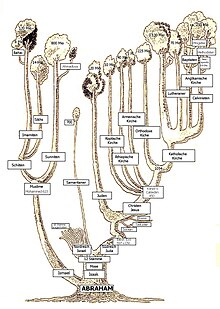Vertical ecumenism
The Vertical ecumenism is a by Othmar Keel developed and widely published concept for achieving mutual recognition and sustainable understanding between the monotheistic religions and polytheistic religions - and basically all religions - as equal partners.
A look at the polemics, arrogance and self-righteousness contained in the writings to establish one's own identities and their motives shows what role they played in too many unnecessary mutual injuries and violent confrontations.
The “vertical” element focuses on the historical relationships between the various, often absolutized, phases of the great religious traditions.
purpose
For what religions?
The purpose of religions is to help us humans interpret our experiences and to show ways to a meaningful and good life, to shed light on the whence and where we are going, to guide us in dealing with suffering, illness and strokes of fate, with injustice and guilt. Religion can give us a spiritual home and community through symbols, rituals and festivals.
Differences between religions
Because of religiously motivated differences, unprecedented atrocities have been committed by people for thousands of years - especially in the last two world wars. For more than 100 years, people have tried to counter this evil in discussions between representatives of different religions.
In his studies, Keel takes particular account of the circumstances, environments and motives that shaped and accompanied the emergence and further development of monotheistic religions. Since it is obvious that religions absolutize each other as unique in some passages of their writings instead of recognizing each other as complementary, the procedure according to the vertical ecumenism appears as a promising approach to the goal of a peaceful, understanding and productive relationship between the religions.
Ecumenism
In the ecumenical movement currently practiced , Christians of different denominations meet in order to seek and deepen common content in discussions. In another version of ecumenism, the other Abrahamic religions Judaism and Islam are included. Keel describes this procedure as a horizontal ecumenism, which can stagnate in non-binding friendships or position debates.
Abraham
history
The historically barely comprehensible Abraham plays an important but different role in all three monotheistic religions, in that he provides all three monotheistic religions with an instrument to deny their historical pagan heritage. Abraham is used, not to say misused, to disconnect from their predecessor religions (their real ancestors) in order to lead directly back to God through Abraham. This impious self-absolutization makes an effective dialogue impossible. Abraham is made the first Jew by Judaism, the first Christian by Christianity, and the first Muslim by Islam. In all three religions it serves to differentiate between paganism and idolatry, in Christianity and Islam also to differentiate from Judaism.
The oldest texts about Abraham date to the 10th century BC at best. For Islam, Abraham is its founder (sura 22,27 and 26-29), so he could claim to be older and more worthy than Judaism (founder Moses) or Christianity (founder Jesus), which both mixed the religion of Abraham (Sura 9:30).
Abrahamic ecumenism
According to Keel, the so-called Abrahamic ecumenism does not go deep enough, since it ignores the fact that all three monotheistic faiths are not only closely related to one another, but also all three have essential roots in the pagan religions.
All monotheistic religions are united by the belief in a single, invisible God, the creator of everything visible and invisible. This belief has nothing to do with the biblical Abraham. This gives rise to the problem of Abraham as an integrative figure. The recognition of the real polytheistic roots of the three monotheistic religions is masked by the postulated origin in Abraham. This recognition would enable the ecumenical conversation to seriously deal with the actual historical beginnings, which the Abraham projections unfortunately prevent. In addition to the horizontal, a vertical, historical, anti-fundamentalist dimension and real communication, also with the "naturalists" sympathizing with polytheism, could be opened up and made possible.
Origin of monotheism
Judaism
In the 7th / 6th Century BC Jews in Jerusalem began to turn away from the polytheistic, pagan rites and ways of thinking of the peoples around them, towards belief in a single God. On the one hand, this turning away meant a gain, since perceptible creatures hardly show reality in full depth. On the other hand, this was also a loss of essential human experience that reverberates to this day. B. hardly take nature seriously anymore.
Christianity
After Jesus' death, various Christian communities were formed, some of which also had Gnostic or apocryphal traditions. With the adoption of the Christian faith by Emperor Constantine (312 AD) and the declaration of Christianity as an imperial church under Emperor Theodosius (380 AD), this branch of faith achieved a decisive breakthrough. After several subsequent councils to achieve a unified faith, the Council of Chalcedon (451 AD) decided to recognize two natures in Christ (God and man) and to separate all gnostic-apocryphal churches.
The early Christian history of dogma was not just an intellectual and spiritual controversy, as claims to political power also influenced theological decisions.
Islam
Islam emerged in a dominant religious context of the worship of Arab deities and attempts were made to Jewish and Christian individual interests and interpretative differences by resorting to the original and simple religion of Abraham and at the same time recognizing the great pioneers in Judaism (Moses) and Christianity (Jesus, son of Mary) to represent again. A religious community was created on the basis of a new sacred text in Arabic. According to the Muslim self-image, Muhammad revealed the individual suras of the Koran from around 610 AD until his death in 632. He stayed in Mecca until 622 , where his earliest revelations were made, which were mainly directed against the Arab-polytheistic world. In this religion too, political considerations played an important role.
Demarcation
The texts of monotheistic religions are often based on ancient oriental motifs. So comes z. B. the Flood story of an old Babylonian tradition and many of the legal systems that are presented in the Book of Exodus as a revelation to Moses on Sinai, can be found centuries earlier in legal clauses such as B. were carved in stone on the Hammurabi stele . The Judeo-Christian-Islamic religious communities have absolutized themselves right down to their founding papers at the expense of the texts of their predecessors and built their identity largely on the fact that they set themselves apart, blackened, denounced and disparaged each other. As a result, they believed they were rendering a service to God, even if they called on their believers to use violence against those of other faiths.
All three denominations consistently differentiate themselves from the pagan religions, which is a problem not only with regard to a large part of today's enlightened, secular society, but also with regard to its own history and thus the identities of each individual religious community. This in the form of a loss of sensitivity to the forces of nature and their omnipresence.
Problematic passages from religious texts (selection)
- Judaism :
Against pagan peoples : Gen 9.25f EU ; 11.10-26 EU ; Lev 18 EU ; Dtn 4.19 EU ; 7.1-11 EU ; 12, 2f.31 EU ; 18.9-12.14 EU .
Admonitions : Ex 22.17 EU and 19; Dtn 13.7-17 EU ; 20.13-18 EU ; 28.15-68 EU .
- Christianity :
Against Judaism : Mt 21,33-46 EU ; Lk 12.10 EU and parallel passages; Joh 8,43f EU ; Acts 7.51f EU ; 1 Thess 2 : 14-16 EU ; Heb 8,7-13 EU .
Against pagan peoples : Eph 4.17 EU ; 5.3f EU .
Admonitions : Joh 3,8 EU ; 4.22 EU ; Rom 11 EU ; 1 Cor 11.27 EU .
- Islam :
Against pagan peoples, women, Jews, Christians : Suras 2,142-145; 4.51; 4,116-121; 9.3-5; 9.30; 60.10.
Admonitions : Sura 9.28.
- Conciliatory texts from the Bible, which could enable understanding among all people of all denominations : Weish 11: 24-26 EU ; Rom 11:33 EU ; Gal 3.28 EU ; 1 Tim 4.10 EU .
Metaphors used
In order to clarify the mutual condition and connection of the monotheistic religions, Keel needs the metaphors of the family, the generations, the age and the floors as a sequence of phases of life and development etc. This makes it clear that the change from one phase to another, e.g. B. the change from childhood to adult status or from active age to retirement, experience both gains and losses. From this perspective it can be seen that no phase is all good or all bad, and that a new phase does not make the previous one superfluous - which should also apply to the various creeds.
Requirements and application
It would correspond to God's will to seek reconciliation between the religions, to establish and thus to strive for salvation .
requirements
Participants from all relevant classes should be represented at meetings, e. B. also women, poor, disadvantaged, and "common people". As people with the same basic needs, we can respect each other and show willingness to relativize our own position with a view to our divine destiny. We should be ready to follow the processes used to form the identity of our religions under z. Some have made radical delimitations in order to determine conclusions for future behavior. In view of the need for a globally peaceful coexistence among people, we should learn to recognize others as others.
Current application and intent
Vertical ecumenism is currently cultivated between Christianity and Judaism, within the Christian churches of the East and West and in encounters between Christianity and Islam.
The intrinsic values and perspectives of the various monotheistic religions should be respected in their theological dignity, their own claim to absoluteness should be relativized and what they have in common should be made aware of. An interreligious dialogue should be future-oriented and based on honesty towards one's own history.
For an interdenominational ecumenism it can also be seen that the respective dogma stories were not only intellectual and spiritual developments, but that these were also influenced by political claims to power. T. also will be.
See also
literature
- Eduard Gerber: Sects, Church and the Bible in the New Millennium. Bern 1999.
- Othmar Keel: Impulses for the future of the Jewish-Christian dialogue. Lassalle House , Bad Schönbrunn 2007.
- Othmar Keel, Ulrike Bechmann , Wolfgang Lienemann: Vertical ecumenism: Remembrance work in the service of interreligious dialogue. Academic Press, Friborg (Switzerland) 2005, ISBN 3-7278-1516-7 .
- Othmar Keel: Self-Glorification: The Figure of Abraham in Judaism, Christianity and Islam. Schwabe, Basel 2009, ISBN 978-3-7965-2583-4 .
Individual evidence
- ↑ In 1999, the Bernese pastor Eduard Gerber used the expression “vertical ecumenism” for the first time to describe efforts towards Judeo-Christian understanding and contrasted it with inner-Christian dialogue (as “horizontal ecumenism”).
- ↑ a b c d e book: Impulses for the future of the Judeo-Christian dialogue , note 5, 77; 50; 53; 71 and Joh 16,2 EU ; 76
- ↑ a b c book: Vertical Ecumenism , 8; 45
- ↑ a b c d e f g book: self-glorification , note 11, 12; 12; 21; 41; Note 66, 44; 45
Web links
- Monotheism - a Divine Flaw? - ( Neue Zürcher Zeitung of October 30, 2004)
- Bible + Orient Museum, Freiburg im Üechtland
- Book: Muslims Ask, Christians Answer Online
- Trialogue between Jews, Christians and Muslims - ( Hans Kessler in Voices of the Time , 2005/3, p. 171-182)

